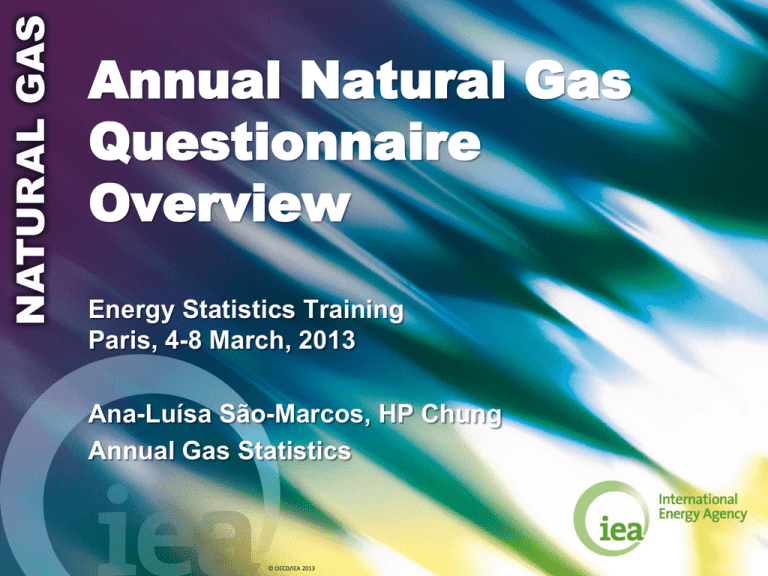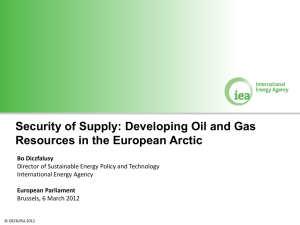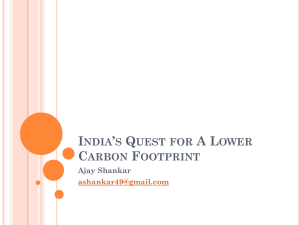AQ_Gas_Overview - International Energy Agency
advertisement

Annual Natural Gas Questionnaire Overview Energy Statistics Training Paris, 4-8 March, 2013 Ana-Luísa São-Marcos, HP Chung Annual Gas Statistics © OECD/IEA 2013 Natural Gas Statistics Plan of the presentation Background to Natural Gas Statistics Definitions; Global trends in Natural gas; Production, supply and consumption Structure of the Questionnaire Structure and presentation; basic concepts, overview of the tables, relations within the questionnaire Data treatment Submission; verification; specific problems Access Natural Gas information/data © OECD/IEA 2013 Natural Gas Statistics Basics Natural Gas comprises gases occurring in underground deposits, whether liquefied or gaseous, consisting mainly of methane. It includes: • Associated gas – found in association with crude oil • Non-associated gas – originating from fields producing hydrocarbons only in gaseous form • Shale gas is included • Colliery gas – methane removed from coal mines and coal seams © OECD/IEA 2013 Gaseous gas Natural Gas Same methane (CH4) content Liquefied gas Different physical state Volume of natural gas varies with temperature and pressure At the IEA measured at 15 degrees Celsius and 1 atm Liquefied gas shrinks more than 600 times in volume Cooled at -160 degrees Celsius and 1 atm © OECD/IEA 2013 World total primary energy supply (1971-2010) Mtoe 16% 21% 2721 Mtoe GAS 977 Mtoe * Other includes geothermal, solar, wind, heat, etc © OECD/IEA 2013 Natural gas production from 1971 to 2011 billion cubic metres (bcm) 1971 2011 2.7 x 3388 bcm 1226 bcm © OECD/IEA 2013 Natural gas production from 1971 to 2011 by region billion cubic metres 1226 bcm 3388 bcm 36% 71% * Asia excludes China © OECD/IEA 2013 •Collecting •Processing •Disseminating 1 product = Natural Gas © OECD/IEA 2013 Natural Gas - Production NGL Other Separation (offshore wells) Extraction of Crude Oil and Associated Gas Associated Gas Gas Flared or reinjected Wellhead Separation (onshore wells) Removal of Liquids in Natural Gas Processing Plants Marketed Production Annual Gas Questionnaire NonAssociated Gas Extraction of Non-Associated Gas Vented Coal Mines Crude Oil Annual Oil Questionnaire Removal of Sulphur and Impurities Colliery Gas © OECD/IEA 2013 Natural Gas - Supply and Consumption Transformation Exports Stock Build Energy Distribution Losses Marketed Production Inland Consumption Transport Imports Stock Draw Residential Commercial Agriculture Industry © OECD/IEA 2013 Questionnaire structure Gas balance Production Imports Exports Stock Change Supply Inland Consumption (Calculated) Statistical Difference Transformation … Energy Sector … Final Consumption Transport … Industry … Other Sectors … Demand Inland Consumption (Observed) © OECD/IEA 2013 Questionnaire structure Gas balance Table 1 Table 2a Production Imports Exports … Table 3 Table 4 Statistical Difference Transformation … Energy Sector … Final Consumption Transport … Table 2b Industry … Other Sectors © OECD/IEA 2013 Table 1 Table 2a Inland consumption Supply Table 2b Total final consumption Tables 3 & 4 Exports/Imports Table 5 Gas storage capacity © OECD/IEA 2013 Table 1 Table 2a Inland consumption Supply Table 2b Total final consumption Tables 3 &4 Exports/Imports Table 5 Gas storage capacity © OECD/IEA 2013 Supply of Natural Gas, Table 1 Year & Country Million m3 (at 15°C, 760 mm Hg) A TJ (Gross Calor. Value) B Average GCV (kJ/m3) Average NCV (kJ/m3) C D Indigenous Production 1 0 Associated Gas 2 0 Non-Associated Gas 3 0 Colliery Gas 4 0 From Other Sources 5 0 Total Imports (Balance) 6 0 Total Exports (Balance) 7 0 International Marine Bunkers 8 0 Stock Changes (National Territory) 9 0 Inland Consumption (Calculated) 10 0 0 Statistical Differences 11 0 0 Inland Consumption (Observed) 12 0 Opening Stock Level (National Territory) 13 0 Closing Stock Level (National Territory) 14 0 Memo: Gas Vented 15 Gas Flared 16 Memo: Cushion Gas Cushion Gas Closing Stock Level 17 Memo: From other sources From Other Sources - Oil From Other Sources - Coal From Other Sources - Renewables 18 19 20 0 0 Recoverable Gas 0 0 0 © OECD/IEA 2013 Natural Gas Questionnaire Definitions and Basic Concepts Supply – Table 1 Indigenous Production • dry marketable production (after purification and extraction of NGL and sulphur) • Exclude gas vented and flared, losses, reinjected quantities Imports and Exports • are considered imported or exported when having crossed the physical boundary of a country • Exclude transit and re-exports Stock changes and levels • stock levels of recoverable gas, i.e. excluding cushion gas • change of stock is opening - closing stock level of recoverable gas © OECD/IEA 2013 Natural Gas Questionnaire Definitions and Basic Concepts Units: Natural gas data are collected in Volume : million m3 - under Standard Conditions (15 degrees Celcius and 760 mm Hg) Energy unit : TJ - Gross Calorific Value Conversion specific kJ/m3 calorific value • Indigenous Production • Imports • Exports • Inland Consumption (calc) • Inland Consumption (obs) © OECD/IEA 2013 Table 1 Table 2a Inland consumption Supply Table 2b Total final consumption Tables 3 &4 Exports/Imports Table 5 Gas storage capacity © OECD/IEA 2013 Inland Consumption, Table 2a Inland Demand (Total Consumption) Inland Demand (Total Consumption) Transformation Sector Unit: TJ (GCV) Consumption A 1 2 Main Activity Producer Electricity Plants 3 Autoproducer Electricity Plants 4 Main Activity Producer CHP Plants Autoproducer CHP Plants Main Activity Producer Heat Plants Autoproducer Heat Plants Transformation sector 5 6 7 8 Gas Works (Transformation) 9 Coke Ovens (Transformation) 10 Blast Furnaces (Transformation) 11 Gas-to-Liquids (GTL) Plants (Transformation) 12 Non-specified (Transformation) 13 Energy Sector 14 Coal Mines 15 Oil and Gas Extraction 16 Petroleum Refineries Coke Ovens (Energy) Energy sector 17 18 Blast Furnaces (Energy) 19 Gas Works (Energy) 20 Own Use in Electricity, CHP and Heat Plants 21 Liquefaction (LNG) / Regasification Plants Gas-to-Liquids (GTL) Plants (Energy) Non-specified (Energy) Distribution Losses Total Final Consumption Only TJ, conversion in m3 is done at the IEA using Calorific value from Table 1 – Inland consumption obs. Distribution losses 22 23 24 25 Total final consumption 26 © OECD/IEA 2013 Natural Gas Questionnaire Definitions and Basic Concepts Inland Consumption - Table 2a Transformation Sector • Natural Gas used for producing another type of energy (electricity, heat) which is then used for final consumption Example: Electrical power company (Main electricity producer) Energy Sector • Natural Gas consumed by Energy Industry to support extraction or transformation activity. Example: Liquefaction plants, Petroleum refineries Distribution Losses (losses due to transport & distribution) Total Final Consumption (end-use sectors) © OECD/IEA 2013 Table 1 Table 2a Inland consumption Supply Table 2b Total final consumption Tables 3 &4 Exports/Imports Table 5 Gas storage capacity © OECD/IEA 2013 Sector\Plant Electricity plant CHP plant Heat plant All production and all fuel used All electricity and heat produced and all fuel used All heat produced and all fuel used All electricity produced and only heat sold with corresponding fuel used Only heat sold and corresponding fuel used Transformation Main activity producer Autoproducer Industry Natural gas consumed in heat and CHP plants for the production of heat used by the plant itself. © OECD/IEA 2013 Inland Consumption, Table 2b Unit: TJ (GCV) Energy Use Energy Use Total Final Consumption Total Final Consumption Transport Sector Road A Non-Energy Use B 1 2 3 of which Biogas 4 Pipeline Transport 5 Non-specified (Transport) 6 Industry Sector 7 Iron and Steel 8 Chemical (including Petrochemical) 9 Non-Ferrous Metals 10 Non-Metallic Minerals 11 Transport Equipment 12 Machinery 13 Mining and Quarrying 14 Food, Beverages and Tobacco 15 Paper, Pulp and Printing 16 Wood and Wood Products 17 Construction 18 Textiles and Leather 19 Non-specified (Industry) 20 Other Sectors Non-energy Use Transport sector TJ (GCV) Industry sector 21 Commercial and Public Services 22 Residential 23 Agriculture/Forestry 24 Fishing 25 Non-specified (Other) 26 Other sectors © OECD/IEA 2013 Natural Gas Questionnaire Definitions and Basic Concepts Final Consumption - Table 2b (= delivered to final consumers) Different Use • Energy Use Report Natural Gas used as fuel (E.g. Compressed natural gas for use in road vehicles, natural gas used in households for heating purposes) • Non-Energy Use Report Natural Gas used as a raw material for producing other products (Petrochemical Industry) E.g. Natural gas used as feedstock to make hydrogen 3 Sectors • Industry Sector (steel plants, cement plants, …) • Transport Sector (CNG in fuel stations, …) • Other Sectors (Households, hospitals, offices, …) © OECD/IEA 2013 Table 1 Table 2a Inland consumption Supply Table 2b Total final consumption Tables 3 & 4 Exports/Imports Table 5 Gas storage capacity © OECD/IEA 2013 Imports/Exports, Tables 3 and 4 Million m3 COUNTRY OF DESTINATION Pipeline+ LNG = Australia 1 Austria 2 Belarus 3 TJ (GCV) Total Exports of which: LNG Total Exports of which: LNG A B C D …. © OECD/IEA 2013 Imports / Exports - Tables 3,4 Requested Data • 2 Units: Million m3 and TJ • Total imports and LNG => pipeline is derived Geographical Breakdown • 70 import origins • 65 export destinations Trade • Importance of the ultimate origin or destination • Transit trade and re-exports are not to be included © OECD/IEA 2013 A special case in trade reporting Imports LNG Regasification process (value added activity) Country A Exports Gaseous gas Country B This is not transit and should be reported in both Imports and Exports tables © OECD/IEA 2013 Table 1 Table 2a Inland consumption Supply Table 2b Total final consumption Tables 3 &4 Exports/Imports Table 5 Gas storage capacity © OECD/IEA 2013 Gas storage capacity, Table 5 Name Type Working Capacity (mcm) Peak Output (mcm/day) Gas security – important energy policy issue in gas consuming countries TOTAL In case of supply disruption it is crucial to know the available storage facilities in one region. © OECD/IEA 2013 Natural Gas Questionnaire Definitions and Basic Concepts Gas Storage Capacity – Table 5 Location of the storage Type of storage • Depleted oil and gas fields • Aquifers • Salt Cavities • for LNG if it is above, in or below ground and # tanks Technical Characteristics • Working Capacity = total gas storage capacity minus cushion gas • Peak Output = maximum rate at which gas can be withdrawn from storage © OECD/IEA 2013 Natural Gas Questionnaire Relations between the tables Oil Oil questionnaire questionnaire Table Table 1 Coal Coal questionnaire questionnaire Table Table 1 Renewables Renewables questionnaire questionnaire Table Table11 LPG Imports = Total Imports Table Table 33 Imports by Origin Origin Imports by Manufactured gases Biogases Exports = Total Exports Table Table 1 Supply Supply Table Table 44 Exports Destination Exports by by Destination Inland Consumption (observed) = Inland Consumption Table Table22 Inland Consumption Inland Consumption ==Transformation Energy+ +Distribution Distribution Transformation ++Energy Losses Total Final FinalConsumption Consumption Losses + Total Electricity and Inputs to Gross Electricity Electricity and Table 2a Table 2a and Heat Production Heat Heat Inland questionnaire questionnaire Net Inland Consumption bySector Sector Consumption by Table 6a 6c Table 6a - 6c Table Table2b 2b Total Consumptionbybysector sector Total Final Final Consumption Energy Energy-use -use Non -energy Non -energy use use © OECD/IEA 2013 What happens when data arrive at IEA? OECD … World … © OECD/IEA 2013 Natural Gas Questionnaire Data treatment What happens when data arrive at IEA? Questionnaire in excel format received via E-mail on Generic Account Or data can be uploaded or entered into a web-based version of the questionnaire (EDC) Data are loaded in the IEA databases Data are checked • Arithmetically • Internal consistency • Inter-fuel comparison • Time Series Check • Comparisons of monthly and annual data • Comparisons with national publications © OECD/IEA 2013 Some specific problems regarding gas reporting Trade increasing difficulties with liberalised market transit trade is often reported as import / export spot purchases exchange contracts Units measurement in million cubic metres under Standard conditions - often reported under Normal conditions data in TJ often reported as Net rather than Gross © OECD/IEA 2013 Accessing Natural Gas information Natural Gas Information (hard copy, pdf) CD-ROM On-line Data Service • Pay-Per-View • Data download Derived publications/analysis: • Energy Statistics of OECD Countries • Energy Balances of OECD Countries • CO2 Emissions from Fuel Combustion © OECD/IEA 2013 Natural Gas Questionnaire Exercise Preparation Key Points Units of Measurement Calorific Values Weighted Average Production Trade: Imports and Exports Electricity and Heat Generation © OECD/IEA 2013 Natural Gas Questionnaire Units of Measurement Energy- Terajoule (TJ) Physical- Volume: 106 cubic meters (Mm3) Volume varies with temperature and pressure Standard Condition Normal Condition 15 ⁰C (288.15 K), 760 mm Hg (1 atm) 0 ⁰C (273.15 K), 760 mm Hg (1 atm) Conversion Factors 1 m3 x 0.948 0.948 m3 x 1.055 © OECD/IEA 2013 Natural Gas Questionnaire Units of Measurement Energy- Terajoule (TJ) Physical- Volume: 106 cubic meters (Mm3) Volume varies with temperature and pressure Standard Condition Normal Condition 15 ⁰C (288.15 K), 760 mm Hg (1 atm) 0 ⁰C (273.15 K), 760 mm Hg (1 atm) Conversion Factors 1 m3 x 0.948 0.948 m3 x 1.055 Same energy content © OECD/IEA 2013 Natural Gas Questionnaire Units of Measurement In the questionnaire, data must be reported: For volume: Mm3 in the standard condition For energy: TJ on the basis of Gross Calorific Value (GCV) © OECD/IEA 2013 Natural Gas Questionnaire Calorific Values The calorific value is heat value obtained from one volume unit of gas (e.g. TJ/Mm3) Gross Calorific Value (GCV) includes all the heat released by the fuel Net Calorific Value (NCV) excludes the latent heat of vaporization The difference between NCV and GCV is typically about 10% for natural gas. For natural gas: NCV ≈ 0.9 GCV © OECD/IEA 2013 Natural Gas Questionnaire Calorific Values Calorific values of gas may differ for different flows such as: Production from different fields or same field but different reservoirs Imports from different countries Calorific values change over time (e.g. imports from different countries) Use a weighted average that takes into account the proportional magnitude of each component rather than treating the components equally © OECD/IEA 2013 Natural Gas Questionnaire Weighted Average Calorific Value Definition: where: CV = Calorific Value (e.g. kJ/kg) Quantity = Physical Quantity (e.g. kg) © OECD/IEA 2013 Natural Gas Questionnaire Weighted Average Calorific Value Example: Country A Fields Site 1 Production 10 Mm3 Calorific Value 30 TJ/Mm3 Energy 300 TJ Site 2 Total 20 Mm3 30 Mm3 35 TJ/Mm3 ? 700 TJ 1 000 TJ © OECD/IEA 2013 Natural Gas Questionnaire Weighted Average Calorific Value Example: Country A Fields Site 1 Production 10 Mm3 Calorific Value 30 TJ/Mm3 Energy 300 TJ Site 2 Total 20 Mm3 30 Mm3 35 TJ/Mm3 33.3 TJ/Mm3 700 TJ 1 000 TJ © OECD/IEA 2013 Natural Gas Questionnaire Production Flow © OECD/IEA 2013 Natural Gas Questionnaire Production Flow © OECD/IEA 2013 Natural Gas Questionnaire Production Flow © OECD/IEA 2013 Natural Gas Questionnaire Production Flow © OECD/IEA 2013 Natural Gas Questionnaire Trade: Imports and Exports Imports: ultimate origin of gas (country of production) Exports: ultimate destination (country of consumption) Transit and Re-exports not include in trade balances Example: Russia exports 200 m3 of natural gas. The pipeline goes through Ukraine before reaching Poland. Ukraine consumes 100 m3 and the rest goes to Poland. Then, Poland consumes 50 m3 of the natural gas and exports 50 m3 to Czech Republic © OECD/IEA 2013 Natural Gas Questionnaire Russian Federation 200 m3 Ukraine 100 m3 Consumed © OECD/IEA 2013 Natural Gas Questionnaire Russian Federation Poland 50 m3 Consumed 200 m3 100 m3 Ukraine 100 m3 Consumed © OECD/IEA 2013 Natural Gas Questionnaire Russian Federation Poland 50 m3 Consumed 50 m3 Czech Rep. 50 m3 Consumed 200 m3 100 m3 Ukraine 100 m3 Consumed © OECD/IEA 2013 Natural Gas Questionnaire Trade: Imports and Exports Example: Russian Federation Country Exports Czech Rep. 50 m3 Poland Ukraine 50 m3 100 m3 Ukraine imports 100 m3 from Russian Federation Poland imports 50 m3 from Russian Federation Czech Rep. imports 50 m3 from Russian Federation © OECD/IEA 2013 Natural Gas Questionnaire Electricity and Heat Generation Generation plants are classified by output: Electricity-only plants CHP (Combined Heat and Power) plants Heat-only plants Generation plants are also classified by function: Main Activity Producers (ex. Nuclear power plant) Autoproducers (ex. Steel mill producing electricity) © OECD/IEA 2013 Natural Gas Questionnaire Exercise Preparation Key Points Units of Measurement Calorific Values Weighted Average Production Trade: Imports and Exports Electricity and Heat Generation © OECD/IEA 2013 Natural Gas Questionnaire Thank you GASAQ@IEA.ORG © OECD/IEA 2013









